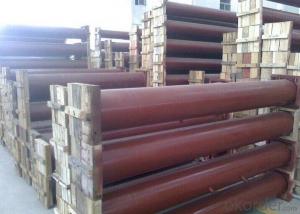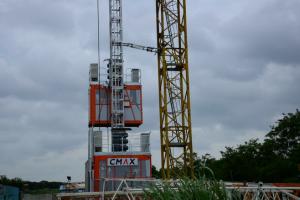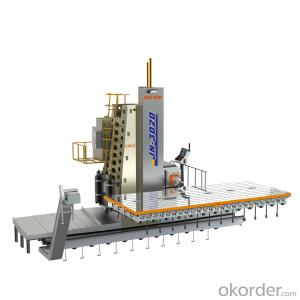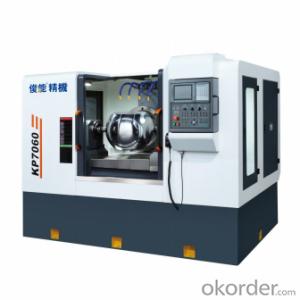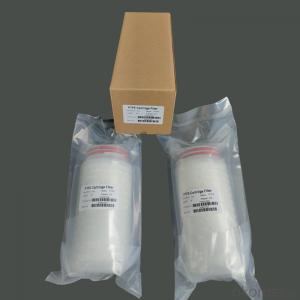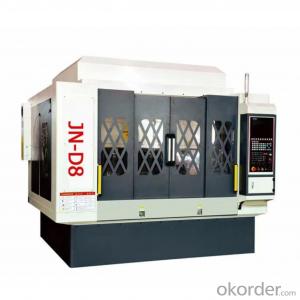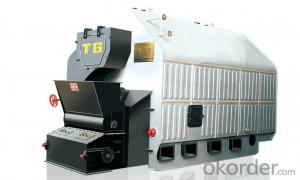PUMPING CYLINDER(PM) I.D.:DN200 CR. THICKNESS :0.25MM-0.3MM LENGTH:1600MM
- Loading Port:
- Shanghai
- Payment Terms:
- TT OR LC
- Min Order Qty:
- 2 pc
- Supply Capability:
- 1000 pc/month
OKorder Service Pledge
OKorder Financial Service
You Might Also Like
Product Description:
The Concrete Pump Delivery Cylinder DN200*1600 normally made by steel material No. C45. according to customer’s requests, and also package in bundles or nude packing directly put into container.
Scope of Application of the Cylinders
The Pump Delivery Cylinder DN200*1600 is a concrete pumping for combined use with other concrete pumps in concrete pumping operations. It can be widely used in the construction of various types of concrete structures like industrial and civil buildings, bridges, roads, and other types of infrastructure.
This Cylinder DN200*1600 can only be used in concrete pump construction operations, but not in any other operations, like dragging, moving, or hoisting heavy articles or personnel. The pipe is also not allowed to be used in any location where any combustible or explosive material exists or a cave-in may occur.
Specifications:
Concrete Pump Delivery Cylinder DN200*1600
1. Capacity: 60,000~80,000cbm
2. Size: DN180, DN200, DN230..
3. Material: C45
4. quenching and tempering to improve the hardness to HB241-280
5. inner wall chrome thickness is 0.25-0.30mm, hardness HV820-900.
6. Brand: SCHWING, PM, SANY, KYOKUTO, CIFA
7. Capacity: 60,000~80,000cbm
Product Advantages:
OKorder's Cylinders DN200*1600 Channels are durable, strong, and safety.
Main Product Features:
· Premium quality
· Prompt delivery & seaworthy packing (10-20 days)
Reliable performance
Easy to weld
High safety.
· Professional Service
· Competitive pricing
Measuring of wall thickness from the outside
Low purchase cost
FAQ:
Q1: How long about delivery time about DN200*1600 ?
A1: Normally we keep the raw materials for old customers and sometime we also keep stock products to make sure delivery time in any emergency cases.
Q2: How do we guarantee the quality of our Cylinders DN200*1600 ?
A2: We have established an advanced quality management system which conducts strict quality tests at every step, from raw materials to the final product. At the same time, we provide extensive follow-up service assurances as required.
Q3: How soon can we receive the product after purchase?
A3: Within three days of placing an order, we will book the vessel for goods. The specific shipping date is dependent upon international and government factors, but is typically10 to 30 workdays.
Q4: If we can produce some Cylinders DN200*1600 according to customers request?
A4: Yes, we can produce Cylinders DN200*1600 according to the difference country situations to make it suitable to the market and customers. We have very professional technical team to make the design.
Q5: How to make a quick resolution for after service?
A5: OKorder and our manufacture both have overseas branches all-around of world, If needed,
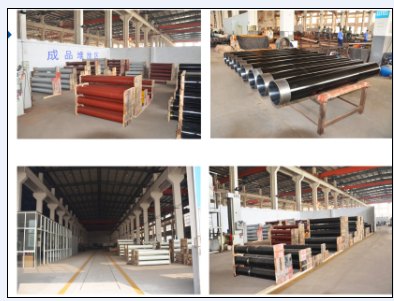
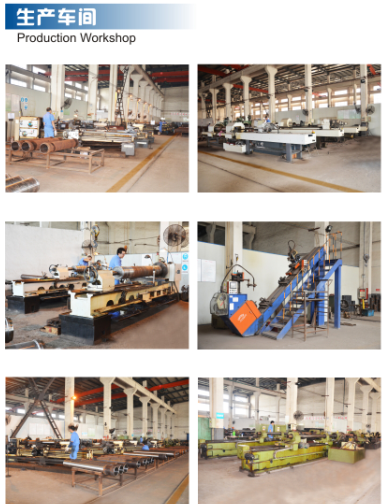
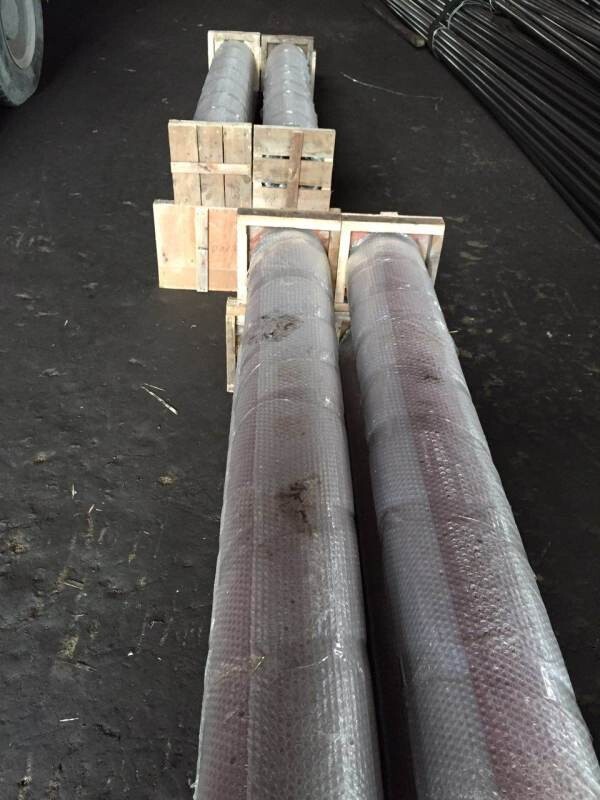
- Q:What is the purpose of a concrete pump cylinder?
- The purpose of a concrete pump cylinder is to provide the necessary pressure and force to transport and deliver concrete from the pump to the desired location. The cylinder is an essential component of a concrete pump, as it allows for the efficient movement of concrete through the pump system. The cylinder works by using hydraulic pressure to push the concrete through the pipeline, ensuring a continuous and smooth flow of concrete. It plays a crucial role in construction projects, enabling concrete to be precisely and efficiently placed in various locations, such as buildings, bridges, or other structures. By providing the necessary power and pressure, the concrete pump cylinder ensures that concrete can be transported over long distances, vertically or horizontally, with minimal effort and labor. Overall, its purpose is to facilitate the efficient and precise delivery of concrete, saving time and effort in construction projects.
- Q:Can I get spare parts for both concrete pumps with and without boom stabilizers?
- Both concrete pumps with and without boom stabilizers have spare parts available. Concrete pump manufacturers typically offer a wide range of spare parts to ensure the longevity and smooth operation of their equipment. These spare parts may include hydraulic components, valves, hoses, seals, wear plates, pipes, and more. Whether your concrete pump has a boom stabilizer or not, you can easily find and purchase spare parts from the manufacturer or authorized dealers. Furthermore, there are aftermarket suppliers who specialize in providing spare parts for various concrete pump models. Therefore, regardless of the specific features of your concrete pump, you can be confident that spare parts are readily available to maintain the smooth functioning of your equipment.
- Q:How is a concrete pump pipe different from a regular pipe?
- A concrete pump pipe is specifically designed for pumping high-pressure concrete mixture from a concrete pump truck to the desired location. Unlike a regular pipe, a concrete pump pipe is made of high-quality and durable materials such as hardened steel or alloy, which can withstand the high pressures and abrasion caused by the concrete mixture. One key difference between a concrete pump pipe and a regular pipe is the thickness of the walls. Concrete pump pipes have thicker walls to ensure they can handle the high pressure and abrasive nature of the concrete mixture. Regular pipes, on the other hand, are designed for various purposes such as water or gas transportation and therefore may not have the same level of thickness and durability. Additionally, concrete pump pipes often come with different end connections, such as flanges or couplings, to allow for easy connection and disconnection to the concrete pump truck and other pipeline components. This ensures a secure and leak-free transfer of the concrete mixture. Furthermore, concrete pump pipes may also have special design features to enhance their performance and longevity. These features can include wear-resistant linings, heat treatment, or galvanization to prevent corrosion and extend the lifespan of the pipe. In summary, a concrete pump pipe differs from a regular pipe in terms of its materials, thickness, end connections, and design features. These differences enable concrete pump pipes to handle the unique requirements of pumping high-pressure concrete mixtures efficiently and effectively.
- Q:What are the advantages of using carbon fiber components in concrete pump spare parts?
- Using carbon fiber components in concrete pump spare parts offers numerous benefits. To begin with, carbon fiber is renowned for its exceptional strength-to-weight ratio. This means that carbon fiber components can provide the same level of strength as traditional materials like steel or aluminum, but with significantly less weight. Consequently, spare parts made from carbon fiber are lighter, making them easier to handle and install, while also reducing the overall weight of the concrete pump system. Furthermore, carbon fiber exhibits remarkable resistance to corrosion. Unlike steel, carbon fiber does not rust or deteriorate when exposed to moisture or chemicals. This makes it an ideal material for concrete pump spare parts, as they are constantly exposed to water, cement, and other corrosive substances. The corrosion resistance of carbon fiber ensures the long-lasting durability of the spare parts, diminishing the need for frequent replacements and maintenance. Another advantage of carbon fiber components is their high stiffness. Carbon fiber is well-known for its rigidity and minimal flexural deformation, meaning that spare parts crafted from carbon fiber experience minimal deflection when subjected to heavy loads. This stiffness helps maintain the overall stability and performance of the concrete pump system, ensuring accurate and efficient pumping of concrete. In addition, carbon fiber demonstrates excellent fatigue resistance. Since concrete pump spare parts endure continuous cyclic loading and unloading, they are susceptible to fatigue failure over time. However, carbon fiber components possess the ability to withstand these cyclic loads without compromising their structural integrity. This enhances the reliability and lifespan of the spare parts, reducing downtime and maintenance costs. Lastly, carbon fiber offers unparalleled design flexibility. It can be easily molded into intricate shapes and geometries, allowing for the creation of customized spare parts tailored to specific requirements. This design flexibility empowers the optimization of spare parts' performance, enhancing the overall efficiency and productivity of the concrete pump system. In conclusion, utilizing carbon fiber components in concrete pump spare parts presents a multitude of advantages, including their outstanding strength-to-weight ratio, corrosion resistance, stiffness, fatigue resistance, and design flexibility. These qualities contribute to the enhanced performance, durability, and cost-effectiveness of the concrete pump system.
- Q:What is the role of a concrete pump cylinder in a pumping system?
- The role of a concrete pump cylinder in a pumping system is to generate the necessary pressure and force required to transport concrete from the hopper or storage container to the desired location. The cylinder plays a crucial role in the pumping process by creating a reciprocating motion that helps in pushing the concrete through the pipeline. The concrete pump cylinder is typically connected to a piston, which moves back and forth inside the cylinder to create the pumping action. As the piston moves towards the outlet end of the cylinder, it creates a vacuum that sucks in the concrete from the hopper. When the piston moves in the opposite direction, it compresses the concrete and forces it out through the outlet valve, into the pipeline, and ultimately to the designated area. The size and design of the concrete pump cylinder depend on various factors such as the desired pumping capacity, the distance the concrete needs to be transported, and the viscosity of the concrete mix. It is essential for the cylinder to be strong and durable to withstand the high pressures and repetitive movements involved in the pumping process. In summary, the concrete pump cylinder is responsible for generating the necessary pressure and force to transport concrete efficiently and effectively. It forms the backbone of the pumping system, enabling the smooth and continuous flow of concrete from the hopper to the desired location.
- Q:How often should carbide wear plates be replaced in a concrete pump?
- The frequency of replacing carbide wear plates in a concrete pump depends on various factors such as the quality of the carbide, the amount of usage, and the conditions in which the pump operates. Generally, carbide wear plates may need replacement every 6 to 12 months, but regular inspection and monitoring of their condition is essential to determine the actual replacement interval.
- Q:What are some common issues with concrete pump hoses and how can they be prevented?
- Concrete pump hoses can encounter various problems such as blockages, leaks, and premature wear. To avoid these issues, it is essential to adhere to proper maintenance and usage practices. 1. Blockages: Blockages can occur when concrete or debris hardens inside the hoses. Thoroughly cleaning the hoses after each use is crucial to prevent blockages. Flushing the hoses with water or using a cleaning sponge ball effectively removes any residue or build-up. Additionally, using the correct size and length of hose for the job reduces the risk of blockages. 2. Leaks: Leaks may result from wear and tear, improper connections, or hose damage. Regularly inspecting the hoses is vital to detect any signs of leakage. Any leaks detected should be promptly repaired or replaced. Properly connecting and securing the hose fittings also helps prevent leaks. 3. Premature Wear: Over time, concrete pump hoses can wear out due to factors such as abrasion, bending, and exposure to harsh chemicals. Handling the hoses with care and avoiding dragging them on rough surfaces is important to prevent premature wear. Using protective sleeves or guards provides additional protection against abrasion. Regularly inspecting the hoses for signs of wear and replacing them when necessary is essential. 4. Storage Practices: Improper storage of concrete pump hoses can cause damage and reduce their lifespan. Storing the hoses in a clean and dry environment away from direct sunlight and extreme temperatures is recommended. Properly coiling the hoses and avoiding sharp bends or kinks helps maintain their integrity. 5. Pressure Management: Exceeding the recommended pressure limits can result in hose bursts or failures. Ensuring that the concrete pump operates within the specified pressure range is crucial. Regularly inspecting the pressure gauges and monitoring the pumping process aids in preventing over-pressurization. By adhering to these preventive measures, conducting regular inspections, and performing necessary maintenance, the common issues associated with concrete pump hoses can be minimized. This, in turn, leads to improved performance and increased longevity of the hoses.
- Q:How does a hydraulic accumulator improve the performance of a concrete pump?
- A hydraulic accumulator improves the performance of a concrete pump by storing excess hydraulic pressure and energy during low-demand periods and releasing it when needed. This allows for a smoother operation, reduced pump pulsation, and improved efficiency in delivering the concrete, resulting in enhanced performance and productivity.
- Q:How does a hopper agitator blade ensure smooth concrete flow?
- A hopper agitator blade ensures smooth concrete flow by constantly mixing and agitating the concrete inside the hopper. This prevents the concrete from settling or forming clumps, ensuring a consistent and even flow of the material. The agitation action of the blade also helps to break up any air pockets that may be present in the concrete, resulting in a more uniform and high-quality mixture.
- Q:What is the function of a concrete pump control box?
- The function of a concrete pump control box is to control and regulate the operation of a concrete pump, including starting and stopping the pump, adjusting the flow rate and pressure of the concrete, and monitoring various parameters such as engine speed and hydraulic pressure. It provides a centralized control system for efficient and safe operation of the concrete pump.
1. Manufacturer Overview |
|
|---|---|
| Location | |
| Year Established | |
| Annual Output Value | |
| Main Markets | |
| Company Certifications | |
2. Manufacturer Certificates |
|
|---|---|
| a) Certification Name | |
| Range | |
| Reference | |
| Validity Period | |
3. Manufacturer Capability |
|
|---|---|
| a)Trade Capacity | |
| Nearest Port | |
| Export Percentage | |
| No.of Employees in Trade Department | |
| Language Spoken: | |
| b)Factory Information | |
| Factory Size: | |
| No. of Production Lines | |
| Contract Manufacturing | |
| Product Price Range | |
Send your message to us
PUMPING CYLINDER(PM) I.D.:DN200 CR. THICKNESS :0.25MM-0.3MM LENGTH:1600MM
- Loading Port:
- Shanghai
- Payment Terms:
- TT OR LC
- Min Order Qty:
- 2 pc
- Supply Capability:
- 1000 pc/month
OKorder Service Pledge
OKorder Financial Service
Similar products
New products
Hot products
Related keywords
